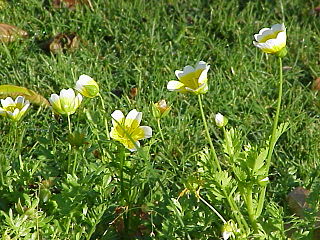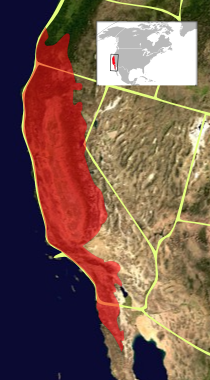Floristic provinces
The region is subdivided into four floristic provinces:
Great Basin province
The Great Basin floristic province includes most of the Great Basin, as well as the Colorado Plateau, the Snake River Plain, and Arizona north of the Mogollon Rim. It shares much of its flora with the neighboring provinces and has only a few endemic genera. Species endemism is also moderate (about 25%), but is much more considerable in such genera as Astragalus , Eriogonum , Penstemon , Cymopterus , Lomatium , Cryptantha , Chrysothamnus , Erigeron , Phacelia , Castilleja , and Gilia .
The vegetation in the central Great Basin shrub steppe part of the province is dominated by Artemisia species and Chenopodiaceae genera. The Great Basin montane forests include ancient Great Basin bristlecone pine (Pinus longaeva) trees.
Californian province
The Californian province occupies Central and Southern California from the seashore to the foothills of the Cascade Range, the Sierra Nevada range, and northern parts of Baja California in Mexico. It possesses the most diverse flora within the floristic region. About half of the species are endemic. More than 50 genera (e.g. Adenostoma , Bergerocactus , Carpenteria , Cneoridium , Dendromecon , Fremontodendron , Jepsonia , Lyonothamnus , Neostapfia , Odontostomum , Ornithostaphylos , Pickeringia , Romneya ) are endemic or near-endemic as well. Arctostaphylos , Brodiaeinae, Calochortus , Caulanthus , Streptanthus , Ceanothus , Cryptantha , Downingia , Dudleya , Eritrichieae, Eriogonoideae, Gileae, Hydrophyllaceae, Limnanthaceae, Lotus , Madiinae, Mimulus , Onagreae, Epilobieae, Orcuttieae, Eschscholzioideae, Platystemonoideae, Astragalus and Cupressus have a principal center of diversity within the province. The flora of the Californian Province is partially shared with the spatially distant Chile-Patagonian region of the Antarctic kingdom and to a lesser extent Mediterranean region of the Holarctic kingdom. The vegetation of the Californian Province is varied. Wetter northern parts of the Californian province (Northern California and Oregon) as defined by Peter Raven and D.I. Axelrod, as well as by Conservation International, fall under the Rocky Mountain region in Takhtajan and Thorne's system and are not parts of the Madrean region.

The Nearctic realm is one of the eight biogeographic realms constituting the Earth's land surface.

The Sonoran Desert is a hot desert and ecoregion in North America that covers the northwestern Mexican states of Sonora, Baja California, and Baja California Sur, as well as part of the Southwestern United States. It is the hottest desert in both Mexico and the United States. It has an area of 260,000 square kilometers (100,000 sq mi).
A phytochorion, in phytogeography, is a geographic area with a relatively uniform composition of plant species. Adjacent phytochoria do not usually have a sharp boundary, but rather a soft one, a transitional area in which many species from both regions overlap. The region of overlap is called a vegetation tension zone.

The Boreal kingdom or Holarctic kingdom (Holarctis) is a floristic kingdom identified (1947) by botanist Ronald Good, which includes the temperate to Arctic portions of North America and Eurasia. Its flora is inherited from the ancient supercontinent of Laurasia. However, parts of the floristic kingdom were glaciated during the Pleistocene and as a consequence have a very young flora. Cenozoic relicts found refuge in the southern and mountainous parts of the kingdom, especially in the Eastern Asiatic Region and southern North American Atlantic Region.

Yucca schidigera, also known as the Mojave yucca or Spanish dagger, is a perennial plant in the asaparagus family native to the southwestern United States and northwestern Mexico. It is most common in the Mojave Desert, but also occurs extensively in the Sonoran Desert and west to the Pacific coast of southern California and Baja California.

The Limnanthaceae are a small family of annual herbs occurring throughout temperate North America. There are eight species and nineteen taxa currently recognized. Members of this family are prominent in vernal pool communities of California. Some taxa have been domesticated for use as an oil seed crop. Some members are listed as threatened or endangered and have been the focus of disputes over development plans

The California Floristic Province (CFP) is a floristic province with a Mediterranean-type climate located on the Pacific Coast of North America with a distinctive flora similar to other regions with a winter rainfall and summer drought climate like the Mediterranean Basin. This biodiversity hotspot is known for being the home of the Sierran giant sequoia tree and its close relative the coast redwood. In 1996, the Province was designated as a biodiversity hotspot allowing it to join ranks among 33 other areas in the world with many endemic species. To be named a biodiversity hotspot, an area has to contain species and plant life that cannot be found anywhere else in the world. The California Floristic Province is home to over 3,000 species of vascular plants, 60% of which are endemic to the province.

The Cape Floral Region is a floristic region located near the southern tip of South Africa. It is the only floristic region of the Cape Floristic Kingdom, and includes only one floristic province, known as the Cape Floristic Province.

The Central Mexican Plateau, also known as the Mexican Altiplano, is a large arid-to-semiarid plateau that occupies much of northern and central Mexico. Averaging 1,825 m (5,988 ft) above sea level, it extends from the United States border in the north to the Trans-Mexican Volcanic Belt in the south, and is bounded by the Sierra Madre Occidental and Sierra Madre Oriental to the west and east, respectively.

The North American Atlantic region is a floristic region within the Holarctic kingdom identified by Armen Takhtajan and Robert F. Thorne, spanning from the Atlantic and Gulf coasts to the Great Plains and comprising a major part of the United States and southeastern portions of Canada. It is bordered by the Circumboreal floristic region in the north, by the Rocky Mountain and Madrean floristic regions in the west and by the Caribbean floristic region of the Neotropical kingdom in the south of Florida. The flora of the region comprises two endemic monotypic families, Hydrastidaceae and Leitneriaceae, and is characterized by about a hundred of endemic genera. The degree of species endemism is very high, many species are Tertiary relicts, which survived the Wisconsin glaciation and are now concentrated in the Appalachians and the Ozarks. A number of genera are shared only with the Canadian floristic province of the Circumboreal region. Moreover, as has long been noted, a large number of relict genera are shared with the relatively distant Eastern Asiatic Region and sometimes Southeast Asia. R. F. Thorne counted at least 74 genera restricted to eastern North America and Asia. The fossil record indicates that during the Tertiary period a warm temperate zone extended across much of the Northern Hemisphere, linking America to Asia.
The native flora of the United States includes about 17,000 species of vascular plants, plus tens of thousands of additional species of other plants and plant-like organisms such as algae, lichens and other fungi, and mosses. About 3,800 additional non-native species of vascular plants are recorded as established outside of cultivation in the U.S., as well as a much smaller number of non-native non-vascular plants and plant relatives. The United States possesses one of the most diverse temperate floras in the world, comparable only to that of China.

The Antarctic floristic kingdom, also the Holantarctic kingdom, is a floristic kingdom that includes most areas of the world south of 40°S latitude. It was first identified by botanist Ronald Good, and later by Armen Takhtajan. The Antarctic Floristic Kingdom is a classification in phytogeography, different from the Antarctic realm classification in biogeography, and from Antarctic flora genera/species classifications in botany.

The Eastern Asiatic region is the richest floristic region within the Holarctic kingdom and situated in temperate East Asia. It has been recognized as a natural floristic area since 1872 August Grisebach's volume Die Vegetation der Erde and later delineated by such geobotanists as Ludwig Diels, Adolf Engler, Ronald Good and Armen Takhtajan.

The Rocky Mountain Floristic Region is a floristic region within the Holarctic Kingdom in western North America delineated by Armen Takhtajan. The region extends from Kodiak Island in Alaska to the San Francisco Bay Area and Sierra Nevada in California. It consists of two provinces, the Vancouverian, which comprises the coastal part of the region for its entire length, including the Pacific Coast Ranges, and the Rocky Mountain, which includes the Rocky Mountains and associated ranges. There are no endemic plant families in the region but many endemic genera and species.

The Circumboreal Region in phytogeography is a floristic region within the Holarctic Kingdom in Eurasia and North America, as delineated by such geobotanists as Josias Braun-Blanquet and Armen Takhtajan.

The Paleotropical kingdom (Paleotropis) is a floristic kingdom composed of the tropical areas of Africa, Asia and Oceania, as proposed by Ronald Good and Armen Takhtajan. Part of its flora is inherited from the ancient supercontinent of Gondwana or exchanged later. These Gondwanan lineages are related to those in the Neotropical kingdom, composed of the tropical areas of Central and South America. Flora from the Paleotropical kingdom influenced the tropical flora of the Australian Kingdom. The kingdom is subdivided into five floristic subkingdoms according to Takhtajan and about 13 floristic regions. In this article the floristic subkingdoms and regions are given as delineated by Takhtajan.
The Saharo-Arabian region is a floristic region of the Holarctic kingdom proposed by Armen Takhtajan. The region is covered by hot deserts, semideserts and savanna.

Yucca × schottii is a plant species in the genus Yucca, native to southern Arizona, southwestern New Mexico, and the northern parts of Sonora and Chihuahua. The common names are Schott's yucca, hoary yucca, and mountain yucca. The "×" in the name indicates that this is a nothospecies, regarded as being a natural hybrid between two other species. In this case, Yucca × schottii is believed to have originated as a hybrid between Y. baccata and Y. madrensis. Yucca × schottii is firmly established and does reproduce freely in the wild.

The Great Basin Province is a floristic province of the Madrean subkingdom, in the Boreal kingdom. It is located in the Western United States.

Flora of the Colorado Desert, located in Southern California. The Colorado Desert is a sub-region in the Sonoran Desert ecoregion of southwestern North America. It is also known as the Low Desert, in contrast to the higher elevation Mojave Desert or High Desert, to its north.



















